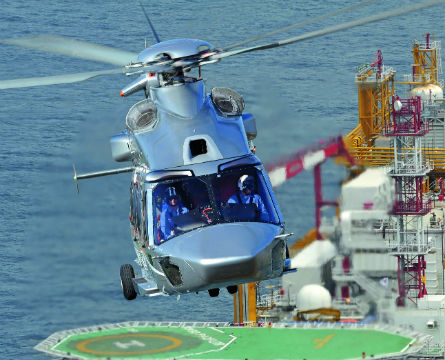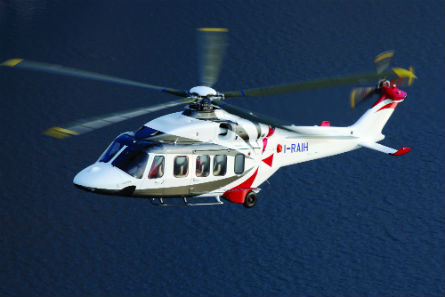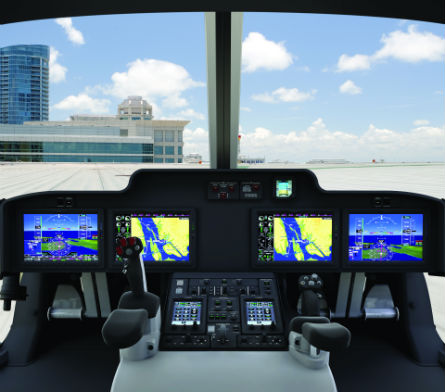This year's Farnborough air show will shine a spotlight on a range of different new helicopter developments through which the airframers want to drive their future business. While commercial sales have recovered since the rotary-wing market fell off a cliff in 2008, the original equipment manufacturers now have to adapt to government budget cuts and a new procurement ethos in the military arena.
AgustaWestland will be showing the super-medium AW189 - which flew for the first time in December and is expected to enter service by early 2014 - as well as a new military variant of its medium-sized AW139 series. Given the first flight of the AW169 in May, many will expect the Anglo-Italian manufacturer also to bring the new medium twin to Farnborough. "I would like to leave [scope for] some surprise," Roberto Garavaglia, senior vice-president marketing, remarks promisingly, although he does not confirm whether the AW169 will make an appearance at the show.
Bell Helicopter is going to present the mock-up of its future 525 "Relentless" super-medium twin, which it revealed for the official programme launch at the Heli Expo in Dallas in February. The development has just entered the detailed design phase, with the first flight planned for 2014. No service-entry target has yet been announced, but Larry Thimmensch, vice-president commercial programmes, says that the US manufacturer aims to mature the all-new model during the design phase much more than in previous programmes and thus keep the flight-test period brief.
Eurocopter will be demonstrating the medium EC175, which is to be certificated late this year or "very early" 2013, says Dominique Maudet, executive vice-president global business and services. Oil and gas customers will be among the first operators next year, with a search-and-rescue (SAR) variant to follow next and a VIP one due circa 2015.
 |
|---|
| Eurocopter Oil and gas customers will be among the first to operate the EC175 |
While the Franco-German-Spanish manufacturer turned heads with its high-speed demonstrator X3 at the Paris air show last year, the AS365/EC155 Dauphin-based experimental aircraft with two side-mounted propellers and a rotorless empennage is not available this year - at least not on this side of the Atlantic. The helicopter is touring the USA, where its hybrid concept was presented to potential military and commercial customers. Eurocopter says that it might hold a briefing of the campaign at Farnborough.
Sikorsky will be showing its S70i, the latest derivative of its Black Hawk military helicopter. Even though the US manufacturer's new S76D is nearing the end of its flight tests for planned certification in October, the six-tonne aircraft will not be presented in the UK. Robert Kokorda, vice-president sales and marketing, says the company did not want to interrupt the outstanding tests.
RAIDER WAIT
The airframer also decided not to showcase the planned S-97 "Raider" light tactical helicopter - the follow-up production type of the experimental high-speed demonstrator X2 - although mock-ups have been displayed at US conventions. The X2, featuring a coaxial counter-rotating twin rotor and pusher propeller at the tail, reached 250kt in level flight September 2010, before it was retired last year to be displayed at Smithsonian Institution's National Air and Space Museum near Washington DC.
"It is a little early to show off the S-97 Raider, which is planned to fly in late 2014," says Korkoda. He reports, however, that production and testing of initial components, such as the rotor-blade design and parts for the carbon-composite fuselage, have begun and that the programme is progressing according to plan.
A central aim of AgustaWestland's is commonality between the AW139, AW169 and AW189. Garavaglia says the manufacturer wants to adopt as much as possible a family concept similar to the Airbus A320 and Boeing 737 series. While common pilot-type ratings will not be possible as the variously sized helicopters are powered by different engines, Garavaglia says there are other areas for "significant" operator savings. Coherent cockpit layout and information display will, for example, create a similar "touch and feel" for flight crew and thus create training synergies. All aircraft are designed to the same certification standards and offer common safety features, such as tail rotors with sufficient ground clearance to walk underneath. Maintenance procedures will be standardised.
 |
|---|
| AgustaWestland AgustaWestland's AW189 is to enter service by early 2014 |
Development of the tiltrotor model AW609 has been accelerated "back to speed", according to Garavaglia, after AgustaWestland bought out the programme, which is based on the military Bell-Boeing V22 Osprey (which will be in Farnborough), from former project partner Bell last year. Two prototypes are flying - one in the US and the other in Italy - with certification planned for 2016.
STEPPING UP
While the schedule is "more than reasonable", Garavaglia says that the AW609 bore "by definition more question marks" than conventional helicopters developments. Despite its complex technology and potential cost disadvantages versus other hybrid architectures, he is sure, however, that the power-lift aircraft will find its niche. In terms of range and cruise efficiency at high altitude - which it can reach due to its pressurised cabin - the AW609 will fly in its own class, argues Garavaglia. He adds that market interest has increased since the programme has been refuelled.
Eurocopter's future medium-lift model X4 will still have a conventional rotor layout, but should bring "breakthrough technologies" for reduced operating costs, 30% lower fuel consumption and noise emissions, improved handling and fly-by-wire flight controls, says the manufacturer. The innovations will be introduced in a stepped manner, with the airframe due to enter service in 2017 and the final cockpit configuration to follow in 2020.
Pratt & Whitney Canada's PW210 engine has been selected for the initial version of the X4, but Maudet says another powerplant will become available as part of the second wave. Turbomeca has been working on the future TM800 engine series for the new helicopter type, which it is aiming to have ready for the X4's service entry. Last year, the French government injected a €500 million ($628 million) development fund into the X4 programme, which is split between Eurocopter and project partners Daher, Thales and Turbomeca parent Safran.
This year, Eurocopter wants to decide whether to introduce an electric rotor drive system, which it is testing to increase safety on its single-engine helicopters. The hybrid drive system is not designed to maintain full power during a main engine failure, but to provide supplemental power and more control during emergency landings, which would otherwise depend entirely on autorotation. The manufacturer has developed the equipment with Safran as part of the wider move toward a more electric systems architecture and tested it since last year. Maudet says initial trials showed that the technology made autorotation descents "far more easy and comfortable".
Sikorsky president Jeff Pino revealed in February that the US manufacturer is studying a potential new model in the medium-heavy class between the 6t S-76D and 12t S-92. But Korkoda says that the airframer would have no further news on these evaluations at Farnborough.
He adds that the company is assembling several prototypes of the CH-53K, the latest version of its heavy-lift helicopter. This is to be employed by the US Marine Corps, although a decision for a production aircraft will not be made until 2017. It is a significant technology development effort for the manufacturer as "not a single part will be common with the [current] CH-53E" variant, says Kokorda. Lift capability is to be increased by 30% while the aircraft's physical footprint remains unchanged.
EARLY ANALYSIS
Bell has just built a systems integration laboratory (SIL) to test how the 525R's onboard equipment will work together as well as a cockpit simulator to evaluate the helicopter's performance and pilot ergonomics.
 |
|---|
| Bell Bell will present its 525 mock-up at Farnborough |
The SIL has been employed at a much earlier stage than in previous programmes, says Thimmensch, due to the "unprecedented" capability of today's analytical tools: "That [capability] combined with a lot of testing allows us to learn so much more before we have a [first] aircraft."
He expects that the enhanced design and testing will further mature the new type before production than in the past and allow a reduction in the flight test programme, which typically takes one to two years.
Bell's development of the 525R is an initiative to drive its largely military-based business towards greater balance between defence and commercial customers. Until now, the US manufacturer has not had a dedicated model in the medium-heavy twin class, which is particularly popular within the buoyant oil and gas sector. But the type will also be offered to SAR, VIP and parapublic service operators.
AgustaWestland's Garavaglia says the European manufacturers have traditionally had to position themselves more flexibly - with a wider base of different commercial and military customers - than their North American peers because of the more fragmented defence market in their home region. As governments cut their budgets and reduce military spending, all manufacturers need to adjust their business models.
Not only are civilian helicoper customers becoming more important, but the military market is changing its procurement ethos, with greater demand for military variants of commercial platforms.
Garavaglia says that the AW139M will not remain a one-off military derivative of an existing civilian type, but that the dual-use approach will be rolled out to other models as well. This allows the firm to offer around 80-90% of capabilities of a dedicated military helicopter at "a fraction of the cost", he says, both for the manufacturer and operator. Eurocopter expects the global military helicopter market to decline throughout the decade until it reaches the same level as the expanding civilian market.
While Asia is set to become the world's largest military helicopter market in the middle of the decade - with deliveries scheduled to go to China, India and South Korea - the USA should maintain its lead in terms of contract value, says the European manufacturer.
Source: Flight International























